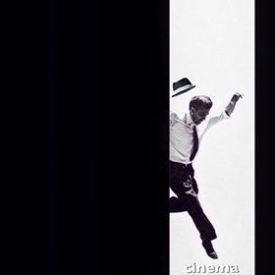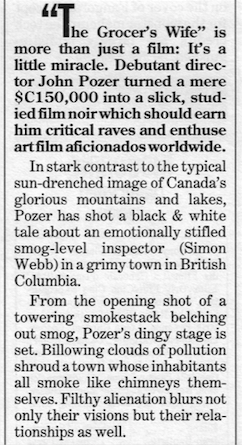When you find an approach, a technique, or a combination of techniques that unlocks a positive flow of creativity in your work — new worlds open up. This can be a powerful discovery that leads you through the uncharted lands of your imagination. This is where the best stories and characters come from.
Frank Daniel taught screenwriting for decades. He encouraged stories to well up from the subconscious mind. Filmmakers need to go deep. The deeper the better.
[Part 4 of a bootlegged transcript from Frank Daniel’s last lecture at Columbia U.]
Now, let’s talk about the way you find stories. There are millions of approaches. You can overhear something, you can meet somebody, you can read something in the newspapers, you can have a conversation with somebody and suddenly an idea for a certain type of a story that no one has done comes to you. These beginnings aren’t something that can be prescribed, that you can rationally categorize, but once begun there are always certain obligations that you have to assume towards your story.
The best stories are stories about human beings, and if you find a character that you believe should be shown and seen, start the exploration of this person.
Those who begin to work on plots first always abominate this part. They think that you don’t need to do it. They fancy that you just select some fixed character units and move them around like puppets, manipulating them so they do what’s necessary to be done, fast and easy. They think you don’t need to involve yourself in the story. But when they finish the first draft there’s the problem of what to do next. They finally have to go back and start thinking about the characters, and then all the plotting becomes questionable. The characters begin to determine the direction in which the story should move. That’s why it’s much better to just accept this unpleasant must.
Know Your Characters
You need to know your character — backwards, forwards, and in depth. That’s the reason why we put together the character questionnaire. You’ve got it, and it helps you to ask all the questions about the character — about his or her relationship to his or her family, to himself, or herself, to his co-worker, to his or her class, work, nature, art, etc. etc. They are all on the list to help you when you start exploring relationships of the character.
The moment you begin to imagine how your character dealt with and deals with his parents, how he gets along with his brothers and sisters, what are the conflicts with his co-workers, and all that, you begin to explore the world of your story, and suddenly scenes begin to emerge. You start putting the character in different situations in your mind, and you begin to hallucinate — to imagine him in the most mundane and exciting moments of his life.
The courage and audacity to deal with trivia and banalities is something you should develop. Because the best stories are made from the most banal material and if you don’t know how your character pays bills, does his laundry, what he likes for lunch and dinner, and what his little vexations are, his petty likes and dislikes, a lively, juicy story will never happen.
I had a wonderful experience this year with one of my students. You know her… She wrote a treatment last year that she brought into class at the beginning of the semester. It was dreadful. It was really very bad, and I had to tell her. So I did, and she was, as you can imagine, quite devastated. And then we sat down and talked for a good three hours. And now that she has a finished script which is really wonderful, I asked her what helped her to write it. She said that she was scared of banalities and trivialities, and that’s why the people in her first year story were cardboard figures And then there was the moment when she tried to see her characters as real, familiar, ordinary people and suddenly she felt free.
“They Will Never Recognize Themselves”
She came to me with the first outline of a new story, and I told her: Right! Use the people whom you know best. Sell all your friends, neighbors, relatives. Everybody has done it. They will never recognize themselves. They have a totally different idea of themselves, and besides your use them in a different context and there’s no danger that they will accuse you of anything. They’ll love the stories, really. Such comedy writers like Lubitsch always made people laugh at themselves without knowing it was them they were snickering at.
Tolstoy’s diary and the notes he kept while he was writing his novels are full of notes how he has combined cousins and friends, his relatives and acquaintances into the fictional personages. Some of them he used directly as he knew or remembered them, some of them he mixed with other people. that’s one of the best ways of finding characters that feel real.
The people, the things, that are familiar, the trivialities, the banalities of life as you observed them are always the spices in a story, in a sequence, in a scene. They make the script believable, they make it come “from somewhere.” The worst stories are stories that don’t have their roots in an environment, in a certain place of life. Such contes are just pure concoctions and no one can relate to them. You can avoid that by starting with exploring that one character that attracts you.
And you should ask yourself why. Why does this character ask to be in a story? What is it I feel about him or about her? Because then you begin to find out why you want to write the whole story, and what the passion of that character is, and why he wants what he wants.
Dream For Your Character
Eventually you reach a moment where you can dream for your character, where you can remember for him or her everything that happened in his or her past. When that happens then you are absolutely safe. The character will find his or her way towards the resolution of the story.
At this point the problem is how to hit that character in his most vulnerable spot. How to put him in the worst predicament imaginable, how to strengthen that predicament, and how you can increase, at the same time, his desire to achieve his dreams. Once you do that, you’ve got a story growing, and there is no problem what to do next.
You just use the rational approach and start asking yourself: what are the sequences in which this character tries to get himself out of the predicament? And you put him or her in that predicament as a rule, in about two sequences, of about 10 – 12 minutes. Then you have the steps from the set up of the dramatic situation to the culmination. When you can see the sequences and you start asking what event you can put in the center of each sequence, the story begins to unravel and then you have a chance to feel quite safe. You begin to have an outline, and you can, after that, begin to write.
The Thread of Your Story
There are people who don’t believe in outlines, so they start writing the script without knowing where they are going. What they end up with is something that resembles a script, because it’s typed in the format, and looks like a script, but it’s not a script, and it’s not a story, although it resembles it, and then, although they have written over a hundred pages and discovered something, they have to go back and decide finally what it is that they want to write about. Eventually, they have to throw away most of the scenes they have written, because the scenes don’t fit in the the new story.
The moment you know what the thread of your story is, you see why those etudes, those hallucinations that you should do before you begin to write, are so important. You all know that actors, for example, when they begin to explore a part, make all kinds of etudes for themselves. They go shopping as the character. They wake up as the character, do their toilet, go to a party, or whatever, as the character. They make up scenes that don’t exist in the script, but these explorations, these etudes, help them to understand all the trivia, all those elements that an actor needs to perform the part. You need to do the same thing.
You better know everything that could and might happen to your character. It’s not writing yet. It’s just the ideation, just the thread count. It needs to be combined with this other side of the process which is asking sober-minded questions like: what is the story about? What is the main character’s problem? What is the difficulty, the stress, in which the character can be put and how can the character solve it?
First Drafts
Personally I believe in a first draft written as fast as possible. When you polish each scene as you go, you stop the flow of your imagination. If you start taking care of every line of dialogue and every adjective in the descriptions, you are under restraint in imagining the total, the whole story. Well, the moment you feel that your character is ready to go on the trip, just start writing.
The best advisable way is to write the first draft without stopping.
And there — it’s only again, my advice, some do take it, some don’t — but my advice is to get used to regular writing hours, and write at least one page a day. For me the best thing is to write in the morning when your mind is more or less fresh, and if it’s not, if you have a hangover, for instance, then you write from a feeling of guilt, and that’s not bad either.
But if you have one finished page written every day that means 360 pages a year, which is enough. That’s three drafts of a script, if you rewrite it completely. But you will learn that the second and third drafts are usually written much faster, so 360 pages can be two scripts a year. That’s just writing one page a day. It gives you a feeling of freedom. You can waste the rest of the day and nothing happens. You have done that one page and you feel comfortable and relaxed.
At the same time something else is happening. You don’t necessarily think consciously about writing for the rest of the day, but subconsciously you still do. Your imagination is at work, unforced, at its leisure. And the next page next day is better.
Also, you shouldn’t ever try to finish everything that is clear in your mind in one writing session. If you do you will find yourself at an impasse. You’ll be stumped. But if you leave part of the scene, or part of the sequence that’s clearly in front of your eyes for the next day, you won’t have that awful feeling of getting started again, because you just continue, and the moment you begin to continue with the things that were clear the day before, new horizons usually open immediately. That’s because the imagination begins to work.
So one page a day — and that’s it. Next day, again.
***












